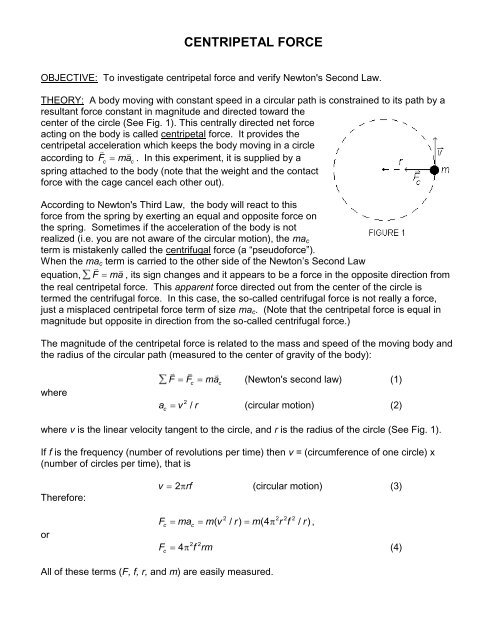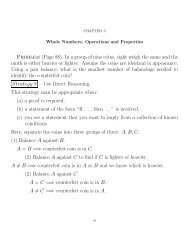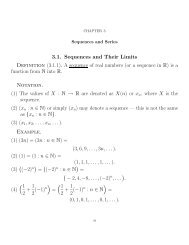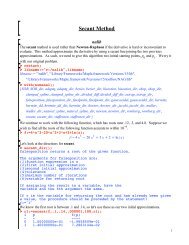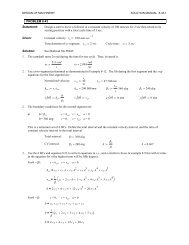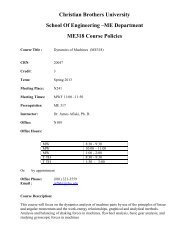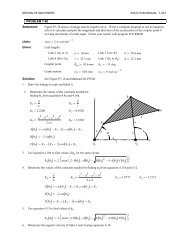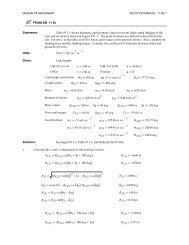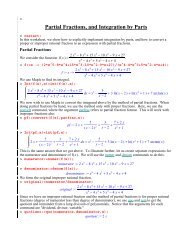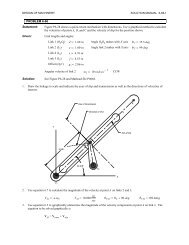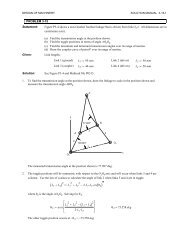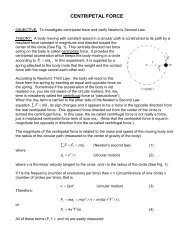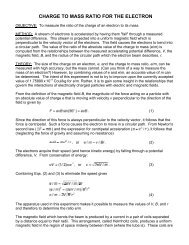CENTRIPETAL FORCE - CBU
CENTRIPETAL FORCE - CBU
CENTRIPETAL FORCE - CBU
Create successful ePaper yourself
Turn your PDF publications into a flip-book with our unique Google optimized e-Paper software.
<strong>CENTRIPETAL</strong> <strong>FORCE</strong><br />
OBJECTIVE: To investigate centripetal force and verify Newton's Second Law.<br />
THEORY: A body moving with constant speed in a circular path is constrained to its path by a<br />
resultant force constant in magnitude and directed toward the<br />
center of the circle (See Fig. 1). This centrally directed net force<br />
acting on the body is called centripetal force. It provides the<br />
centripetal acceleration which keeps the body moving in a circle<br />
according to <br />
Fc<br />
mac . In this experiment, it is supplied by a<br />
spring attached to the body (note that the weight and the contact<br />
force with the cage cancel each other out).<br />
According to Newton's Third Law, the body will react to this<br />
force from the spring by exerting an equal and opposite force on<br />
the spring. Sometimes if the acceleration of the body is not<br />
realized (i.e. you are not aware of the circular motion), the ma c<br />
term is mistakenly called the centrifugal force (a “pseudoforce”).<br />
When the ma c term is carried to the other side of the Newton’s Second Law<br />
<br />
equation, F ma , its sign changes and it appears to be a force in the opposite direction from<br />
the real centripetal force. This apparent force directed out from the center of the circle is<br />
termed the centrifugal force. In this case, the so-called centrifugal force is not really a force,<br />
just a misplaced centripetal force term of size ma c . (Note that the centripetal force is equal in<br />
magnitude but opposite in direction from the so-called centrifugal force.)<br />
The magnitude of the centripetal force is related to the mass and speed of the moving body and<br />
the radius of the circular path (measured to the center of gravity of the body):<br />
where<br />
<br />
F F ma<br />
c c (Newton's second law) (1)<br />
a v 2 c<br />
/ r (circular motion) (2)<br />
where v is the linear velocity tangent to the circle, and r is the radius of the circle (See Fig. 1).<br />
If f is the frequency (number of revolutions per time) then v = (circumference of one circle) x<br />
(number of circles per time), that is<br />
Therefore:<br />
v<br />
2 rf<br />
(circular motion) (3)<br />
or<br />
2 2 2 2<br />
Fc mac m( v / r) m( 4 r f / r)<br />
,<br />
Fc 4 2 f 2 rm<br />
(4)<br />
All of these terms (F, f, r, and m) are easily measured.
Part 1. Testing Newton's Second Law:<br />
PROCEDURE 1:<br />
1) Attach the centripetal apparatus securely to the rotator.<br />
<br />
F<br />
Centripetal Force 2<br />
<br />
ma<br />
2) Tighten the holder with the key attached to the cord. Push the frequency button so that the<br />
display reads the frequency in rev/min (rpm). Slowly increase the speed until the pointer goes<br />
above the button. Slowly decrease the speed until the pointer goes below the button. Record<br />
the frequency for which the pointer is definitely high, for which it is definitely low, and then for<br />
which the pointer points right at the middle of the button. This will give the frequency as well as<br />
the amount of possible uncertainty in the frequency measurement, f f.<br />
3) Record the mass of the moving body, m, that is stamped on the cylindrical body.<br />
4) Next remove the apparatus, and hang it by a piece of string from the stand. The spring<br />
should be near the top. Hang weights on it to stretch the spring until the pointer is again<br />
opposite the button. The tension in the spring is now the same as was exerted on the body<br />
when it was rotating. The spring force now equals the weight of all the mass M attached to the<br />
end of the spring (F = Mg). Be sure to include in the value of M the mass of the rotating body,<br />
m. Estimate the uncertainty M in this value of M by seeing how much mass you can add and<br />
remove to make the pointer definitely move off the center of the button.<br />
5) While it is hanging, measure r from the center (white line) to the line on the body (which<br />
marks the center of gravity). Be sure to estimate the uncertainty r in this measurement.<br />
REPORT:<br />
1. Now we are in a position to check Newton's Second Law. Since we now know f, r, and m,<br />
we can calculate ma c . Do so.<br />
2. The tension in the spring (which is equal to Mg from 4) in the above procedure) provides the<br />
centripetal force F c . Calculate the value of F c .<br />
3. Does F c = ma c ? Find the percent difference using the F c value as the standard.<br />
4. Consider your measurement uncertainties, and comment on whether they are sufficient to<br />
account for the percent error found in step 3 above. To do this, consider the percent<br />
uncertainty for each measurement: % uncertainty = ( /value)*100. When quantities are<br />
multiplied, their percent uncertainties are added. Thus, when a quantity is squared (as<br />
frequency is in the ma c calculation), its percent uncertainty is doubled.<br />
PROCEDURE 2:<br />
Now readjust the tension in the spring by turning the dial by the spring from the zero setting to<br />
the 20 setting (or vise-versa), and repeat the experiment with the spring set at this new tension.<br />
After you have completed the Report section, answer the questions on the next two pages.
Centripetal Force 3<br />
Part 2. Questions About Circular Motion<br />
Answer the following questions using the quantities obtained in Procedure 1. Answer in<br />
complete sentences or equations, such as:<br />
W = m g = (value for mass) x (9.8 m/sec 2 ) = (value for weight).<br />
1. What is the weight (W) of the revolving body of mass (m)?<br />
2. When the mass (m) is being spun around, what is the centripetal force (F c ) on it (magnitude<br />
and direction)?<br />
3. What causes the centripetal force, that is, what physical body or agent exerts the force<br />
necessary to keep the object moving in a circle?<br />
4. What causes the spring to be stretched? (HINT: consider Newton's Third Law)<br />
5. From the point of view of an observer riding on the revolving frame, however, this mass<br />
behaves exactly as if it were in an effective gravitational field with an acceleration due to gravity<br />
(g'). Recall that the revolving mass stretched the spring in our experiment exactly like a heavy<br />
weight did, and the mass would appear stationary (a = 0 m/s 2 ) to such a rotating observer.<br />
Therefore the observer would see the mass pulling “down” on the spring with a weight (W’) that<br />
is equal in size but opposite in direction to the centripetal force that we observe in the laboratory<br />
frame of reference:<br />
<br />
W'<br />
<br />
mg'<br />
<br />
F<br />
<br />
m<br />
c a c<br />
From this point of view, what is the effective weight (W') of the revolving mass (magnitude and<br />
direction)?<br />
6. What is the value of this g' (magnitude and direction)?<br />
7. Using the same radius as you used above, what frequency (f) expressed in rps and rpm<br />
would the mechanism have to rotate at to make the effective weight equal to 100 times the<br />
stationary weight , i.e., W'=(100)W ?<br />
8. Suppose the spring broke while the mass was being rotated. Also assume that the mass<br />
flies off and is not immediately stopped by the end of the rotating mechanism, and neglect the<br />
effect of the real gravity in the room. What path would the mass appear to take as seen by an<br />
observer in the room?<br />
9. What path would the mass in (8) above appear to take as seen by the observer located on<br />
the revolving frame? At first, confine your analysis to the time immediately following the break.<br />
Then extend your analysis to later times.<br />
10. a) Draw a diagram showing the positions of the end of the rotating bar and the flying mass<br />
as seen from the lab frame's point of view at the following five times:<br />
t 1 : the instant the mass starts to leave the end of the rotating bar,<br />
t 2 : the instant when the bar has rotated 90 from the release point,<br />
t 3 : the instant when the bar has rotated 180 from the release point,<br />
t 4 : the instant when the bar has rotated 270 from the release point,<br />
t 5 : the instant when the bar has rotated a full 360 from the release point.
Centripetal Force 4<br />
b) Draw a diagram showing the position of the mass relative to the end of the bar as seen<br />
from the point of view of an observer riding on the end of the rotating bar for each of the five<br />
times in part (a) above.<br />
11. Finally, with your instructor, run the computer program on centripetal motion and compare<br />
your sketches of the motion (question 10) with those generated by the computer, and see if<br />
your answers to question 10 are correct. If the computer is off, turn it and the monitor on. Load<br />
the Physics Menu. From the menu, type L to bring up the Lab menu and then enter 3 to run<br />
the centripetal force routine.<br />
This idea of effective gravity is the principle that explains the operation of a “centrifuge”. The<br />
term "centrifugal force" is sometimes given to what we have called the effective gravity. Hence<br />
the name centrifuge. Note that centrifugal force is not a real force and does not belong in the<br />
<br />
<br />
F term of F ma . However, to an observer on the rotating frame it appears that<br />
centrifugal force is real. Such an observer does not measure the same acceleration as the<br />
stationary observer measures and so must invent a force, the fictitious "centrifugal force", to<br />
account for the difference in acceleration.


